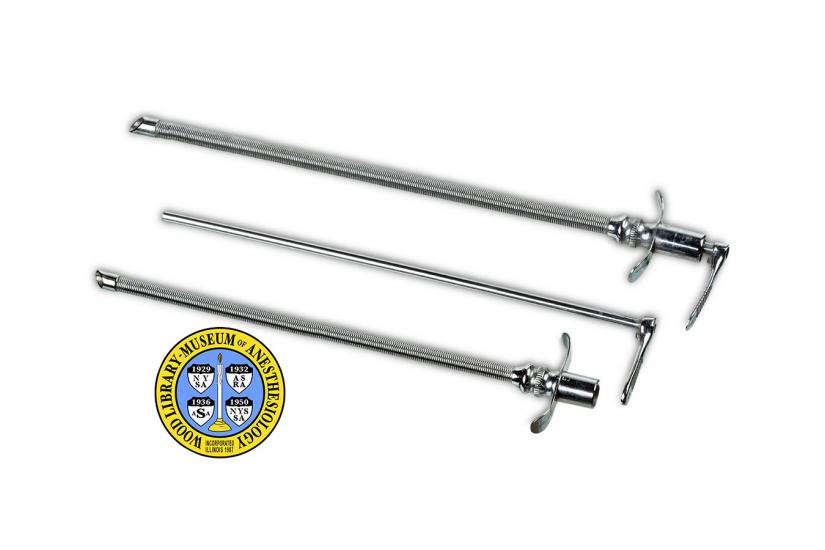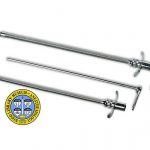Woodbridge Tubes
These flexible metal endotracheal tubes were designed by anesthesiologist Philip D. Woodbridge (1895-1978) and introduced in 1934. An endotracheal tube is inserted through the mouth and into the trachea (wind pipe) to ensure that air can pass freely to and from the lungs.
Dr. Woodbridge’s design is a modification of Dr. Paluel J. Flagg’s endotracheal tube. Dr. Woodbridge believed that his shorter metal tip was less likely to cause irritation or injury. He recommended it for anesthesia during surgeries in which pressure might be applied to the tube.
The main body of the tube is made of tightly coiled wire that can be bent and not kink, and remains patent even if many pounds of pressure are applied to it. This was not true of endotracheal tubes made only of rubber. To make the tube air-tight, the entire coiled portion was covered in removable thin rubber. Pictured here are a size 7, with the stylet inside the tube, and a size 5, with the stylet next to the tube. The stylet keeps the tube rigid and is used only during insertion.
Dr. Woodbridge was a leader to the anesthesiology profession, he established and developed anesthesia departments and residency programs, and was a driving force behind early advancements in anesthesia safety. With fellow anesthesiologist Dr. Ralph Tovell and MIT engineer J. Warren Horton, he investigated the problem of explosions involving static electricity and certain anesthetics. Together they advanced the understanding of the problem and produced preventative solutions, including the Horton Intercoupler.
Catalog Record: Woodbridge Tubes
Two Catalog Records: akwy, akwz
Access Key: akwy
Accession No.: 394
Title: Flexible metal intratracheal tube—Woodbridge : 7.
Author: Woodbridge, Philip Dudley, 1895-1978.
Corporate Author: Foregger Company.
Title variation: Alt Title
Title: Woodbridge tube : 7 mm.
Title variation: Alt Title
Title: Flexible metal intratracheal tube—Woodbridge : 7 (for use with adaptor).
Title variation: Alt Title
Title: Woodbridge tracheal tube, size 7.
Title variation: Alt Title
Title: Woodbridge endotracheal tube.
Publisher: [New York] : Foregger, [between 1934-and 1962].
Physical Descript: 1 endotracheal tube ; metal : 8 x 1.5 x 33 cm.
Subject: Anesthesia, Intratracheal – instrumentation.
Subject: Intubation, Intratracheal – instrumentation.
Subject: Airway Management – instrumentation.
Subject: Airway Management Equipment.
Note Type: General
Notes: The title is taken from the earliest catalog of the manufacturer that
included the number 7 Woodbridge tube (Foregger, 1935).
Note Type: General
Notes: The early year in the date range for the possible year of manufacture is
based on the year that Dr. Woodbridge first introduced his design (1934 in
the journal Anesthesia and Analgesia). The late date is an estimate based on
1960 and 1963 catalogs of the manufacturer. The tube is in the 1960 catalog,
but not in the 1963 catalog. The date range could change if documentation
that indicates the dates should be corrected is discovered.
Note Type: Citation
Notes: Rosenberg H, Axelrod J. Philip Dudley Woodbridge: his contributions to modern
anesthesia. Bul Anesth Hist. April, 1996;14(2):7-8, 17. https://journals.lww.
com/anesthesia-analgesia/Citation/1934/11001/A_Flexible_Metal_Tube_for_Intrat
acheal_Anesthesia.6.aspx. Accessed April 4, 2014.
Note Type: Citation
Notes: Woodbridge PD. A flexible metal tube for intratracheal anesthesia. Anesth
Analg. November-December, 1934;13(6):68-70. https://ahahq.
org/Bulletin/April%201996,%20Vol%2014%20%282%29.pdf. Accessed April 4, 2014.
Note Type: Physical Description
Notes: One metal endotracheal tube with rigid metal stylet; Descriptions and
measurements based on patient perspective, i.e., tracheal tip is the proximal
end, and the connector end is the distal end.; With the stylet in place the
two pieces measure approximately 8 x 1.5 x 33 cm; The body of the tube is
composed of a metal spiral, while the distal and proximal ends are tubular
metal; The length of the beveled, proximal end is approximately 1.9 cm in
length and 1.6 cm in diameter; The length of the coiled portion of the body
is approximately 25.2 cm; The external diameter of the spiraled body of the
tube is about .9 cm; The distal end is the type that was for use with an
adaptor; It measures approximately 5 cm in length, and has two finger grips
that extend in opposite directions; One of the handles is stamped with
“Foregger” and the other with “7”; The handle of the stylet is stamped with
“7”; When the stylet is removed, the body of the endotracheal tube is quite
flexible.
Note Type: Reproduction
Notes: Photographed by Mr. Steve Donisch, September 18, 2013, with a size 7
Woodbridge tube.
Note Type: Historical
Notes: These flexible metal endotracheal tubes were designed by anesthesiologist
Philip D. Woodbridge (1895-1978) and introduced in 1934. An endotracheal tube
is inserted through the mouth and into the trachea (wind pipe) to ensure that
air can pass freely to and from the lungs.
Note Type: Historical
Notes: Dr. Woodbridge’s design is a modification of Dr. Paluel J. Flagg’s
endotracheal tube, introduced in 1928. The primary difference is in the
length of the sold metal tip. Dr. Woodbridge believed that his shorter tip
was less irritating during insertion and less likely to cause any injury. He
especially recommended its use during anesthesia for procedures in which
pressure might be applied to the tube, such as during surgery on the mouth,
neck, or upper chest.
Note Type: Historical
Notes: The main body of the tube is made of tightly coiled wire that can be bent and
not kink, and remains patent even if many pounds of pressure are applied to
it. This was not true of endotracheal tubes made only of rubber. . To make
the tube air-tight, the entire coiled portion was covered in removable thin
rubber. It was originally made in two sizes, 7 and 9, but other sizes became
available. PDescribed here is a size 7, with a stylet. The stylet keeps the
tube rigid and is used only during insertion.
Note Type: Historical
Notes: Not only was Dr. Woodbridge an influential leader in the development of the
profession of anesthesiology, he established and developed anesthesia
departments and residency programs, and was one of the driving forces behind
early advancements in anesthesia safety. He raised money with fellow
anesthesiologist Dr. Ralph Tovell to investigate the problem of explosions
involving static electricity and certain anesthetics. Working with MIT
engineer J. Warren Horton, they advanced the understanding of the problem as
well as developed preventative solutions, including the Horton Intercoupler.
Dr. Woodbridge was also a strong advocate for what eventually became the Pin
Index Safety System.
Note Type: Publication
Notes: Woodbridge PD, Horton JW, Connell K. Prevention of ignition of anesthetic
gases by static spark. JAMA. August 26, 1939;113(9):740-744.
Note Type: Exhibition
Notes: Selected for the WLM website.
Access Key: akwz
Accession No.: 1988-02-24-1
Title: [Flexible metal intratracheal tube—Woodbridge : 5.]
Author: Woodbridge, Philip Dudley, 1895-1978.
Corporate Author: Foregger Company.
Title variation: Alt Title
Title: Flexible metal intratracheal tube—Woodbridge : 5 (for use with adaptor).
Title variation: Alt Title
Title: Woodbridge tube : 5 mm.
Title variation: Alt Title
Title: Woodbridge tracheal tube, size 5.
Title variation: Alt Title
Title: Woodbridge endotracheal tube.
Publisher: [New York] : Foregger, [between 1937 and 1962].
Physical Descript: 1 endotracheal tube ; metal : 8 x 1.5 x 28.5 cm.
Subject: Anesthesia, Intratracheal – instrumentation.
Subject: Intubation, Intratracheal – instrumentation.
Subject: Airway Management – instrumentation.
Subject: Airway Management Equipment.
Note Type: General
Notes: The title is taken from the earliest catalog of the manufacturer that
included the number 5 Woodbridge tube (Foregger, 1942).
Note Type: General
Notes: The early year in the date range for the possible year of manufacture is an
estimate based on the earliest catalog of the manufacturer that included a
number 5 Woodbridge tube. The 1937 catalog did not include a number 5, but
the 1942 catalog did. The late date is an estimate based on 1960 and 1963
catalogs of the manufacturer. The tube is in the 1960 catalog, but not in the
1963 catalog. The date range could change if documentation that indicates the
dates should be corrected is discovered.
Note Type: Citation
Notes: Rosenberg H, Axelrod J. Philip Dudley Woodbridge: his contributions to modern
anesthesia. Bul Anesth Hist. April, 1996;14(2):7-8, 17. https://journals.lww.
com/anesthesia-analgesia/Citation/1934/11001/A_Flexible_Metal_Tube_for_Intrat
acheal_Anesthesia.6.aspx. Accessed April 4, 2014.
Note Type: Citation
Notes: Woodbridge PD. A flexible metal tube for intratracheal anesthesia. Anesth
Analg. November-December, 1934;13(6):68-70. https://ahahq.
org/Bulletin/April%201996,%20Vol%2014%20%282%29.pdf. Accessed April 4, 2014.
Note Type: Physical Description
Notes: One metal endotracheal tube with rigid metal stylet; Descriptions and
measurements based on patient perspective, i.e., tracheal tip is the proximal
end, and the connector end is the distal end.; With the stylet in place the
two pieces measure approximately 8 x 1.5 x 28.5 cm; The body of the tube is
composed of a metal spiral, while the distal and proximal ends are tubular
metal; The length of the beveled, proximal end is approximately 1.5 cm in
length and 1 cm in diameter; The length of the coiled portion of the body is
approximately 21.2 cm; The external diameter of the spiraled body of the
tube is about .8 cm; The distal end is the type that was for use with an
adaptor; It measures approximately 4.3 cm in length, and has two finger grips
that extend in opposite directions; One of the handles is stamped with
“Foregger” and the other with “5”; The handle of the stylet is stamped with
“5”; When the stylet is removed, the body of the endotracheal tube is quite
flexible.
Note Type: Reproduction
Notes: Photographed by Mr. Steve Donisch, September 18, 2013, with a size 7
Woodbridge tube; The size 5 tube is located below and slightly to the left of
the size 7 tube; Also, the size 5 tube and stylet are displayed next to each
other, whereas the size 7 stylet is displayed inside the size 7 tube.
Note Type: Historical
Notes: These flexible metal endotracheal tubes were designed by anesthesiologist
Philip D. Woodbridge (1895-1978) and introduced in 1934. An endotracheal tube
is inserted through the mouth and into the trachea (wind pipe) to ensure that
air can pass freely to and from the lungs.
Note Type: Historical
Notes: Dr. Woodbridge’s design is a modification of Dr. Paluel J. Flagg’s
endotracheal tube, introduced in 1928. The primary difference is in the
length of the sold metal tip. Dr. Woodbridge believed that his shorter tip
was less irritating during insertion and less likely to cause any injury. He
especially recommended its use during anesthesia for procedures in which
pressure might be applied to the tube, such as during surgery on the mouth,
neck, or upper chest.
Note Type: Historical
Notes: The main body of the tube is made of tightly coiled wire that can be bent and
not kink, and remains patent even if many pounds of pressure are applied to
it. This was not true of endotracheal tubes made only of rubber. . To make
the tube air-tight, the entire coiled portion was covered in removable thin
rubber. It was originally made in two sizes, 7 and 9, but other sizes became
available. Described here is a size 5, with a stylet. The stylet keeps the
tube rigid and is used only during insertion.
Note Type: Historical
Notes: Not only was Dr. Woodbridge an influential leader in the development of the
profession of anesthesiology, he established and developed anesthesia
departments and residency programs, and was one of the driving forces behind
early advancements in anesthesia safety. He raised money with fellow
anesthesiologist Dr. Ralph Tovell to investigate the problem of explosions
involving static electricity and certain anesthetics. Working with MIT
engineer J. Warren Horton, they advanced the understanding of the problem as
well as developed preventative solutions, including the Horton Intercoupler.
Dr. Woodbridge was also a strong advocate for what eventually became the Pin
Index Safety System.
Note Type: Publication
Notes: Woodbridge PD, Horton JW, Connell K. Prevention of ignition of anesthetic
gases by static spark. JAMA. August 26, 1939;113(9):740-744.
Note Type: Exhibition
Notes: Selected for the WLM website.


